Your feedback is important to us
Please provide any feedback you have. Thank you!
Thank you!
Your feedback has been submitted.
 California Assessment of Student Performance and Progress
California Assessment of Student Performance and Progress
Please provide any feedback you have. Thank you!
Your feedback has been submitted.

See what skills are tested, understand your child's scores, and get ideas for how you can help at home.
Sixth graders are expected to read articles and books with a critical eye. This means asking questions that get at the author’s motivation: What is the author’s background? Who is the author writing for? Why might the author write this piece at this moment in history?
Sixth graders also need to learn to recognize which statements are backed by evidence and which are not. What proof does the writer give for her ideas? Does the evidence make sense?
Sixth graders are expected to be reading and analyzing so-called “complex” texts. For example, thanks to its figurative language and themes dealing with challenging issues such as loss, the Harry Potter series counts as complex text.
Finally, sixth graders are expected to keep trying even when the reading gets tough, so encourage your child to re-read sections that are difficult. When that science text isn’t making much sense to your child, show him how to use the chapter description, headers, images, and glossary to figure out main ideas, and then encourage him to try reading that section again.
See what’s expected of middle school readers.

At this stage, your child should recognize which details are related to the central theme and which are slightly off topic. Take an article about how great white sharks use the element of surprise to hunt their prey. It might be interesting to know that they can go one or two months without another big meal, but that information is not directly related to their hunting practices.
To make sense of unknown words, sixth graders should be able to use several strategies, including guessing the meaning from context, looking up a word in the dictionary, and getting the idea of the word from its root word, prefix, or suffix. For example, if they know trans means across and port means to carry, they can figure out that transport means to carry things from one place to another. Sixth graders should also be developing the ability to think symbolically when reading figurative language. When faced with an idiom such as stuck between a rock and a hard place, they should know this is not about being wedged underneath a literal boulder.
Figurative language can be especially challenging for people whose first language isn’t English. They must learn the literal meaning of words before interpreting symbolism in phrases. (Imagine trying to understand Let sleeping dogs lie if you were learning English!)
Offer your child opportunities to practice reading texts that are considered challenging for sixth graders, such as Wonder by R.J. Palacio. Make reading a source of pleasure by catering to your child’s interests. This means not just reading books but reading magazines, comics, online articles, and blogs. Your sixth grader should be reading at least 30 minutes a day. Here are some high-level and interesting books for your sixth grader.
Want to know one of the most powerful ways to inspire your child to read? Read for your own pleasure! Seeing you read the morning newspaper, a book before bed, or a favorite blog goes a long way toward showing how reading can enrich a person’s life. Establish a regular 30-minute (or more) family reading time (daily is best, but weekly can work). Everyone in the family has a book, magazine, or tablet to read. When the time ends, ask everyone to share what they learned.
Find out what your child enjoys reading and look for audiobooks so she can read along with the audio version. The first time she may just listen to a chapter, but the second or third time she’ll be reading along. Children can read texts above their level if they are highly interested or already know something about the topic. Audiobooks are also a wonderful way to add some reading firepower to long school commutes!
Children learn through doing. Explore a museum or park and let your child’s questions about what he sees guide your conversations. By talking with him about the jellyfish at the aquarium, for example, you will build his vocabulary and stimulate his curiosity. (Museums can be pricey, but most have at least one free day per month. And free parks can generate questions just as easily without the fees.)
It’s important for sixth graders to build their academic vocabulary. These words are broadly used in many subjects and even in everyday conversation, but kids sometimes have trouble understanding their meaning. The words encourage, unique, chronological, and priority are examples of academic vocabulary. Print out this list of academic vocabulary words that your sixth grader should know and post it on your fridge. Try to use these words in context with your child, and see if she can use them correctly. This will help improve your child’s reading, speaking, and writing.
As the texts they read get increasingly challenging, sixth graders see more metaphors (comparisons of two unlike things — life is a highway) and similes (comparisons using like or as — as brave as a lion). To understand these well, children need lots of exposure as well as explanations. Look for books that use this language. Talk about the words used to make comparisons. Here are a few books teachers recommend:
The Phantom Tollbooth by Norton Juster
Catherine, Called Birdy by Karen Cushman
Snicker of Magic by Natalie Lloyd
Encounter by Jane Yolen
Fair Weather by Richard Peck
These lessons at BeaLearningHero.org will give your child some practical experience reading a variety of subjects, finding evidence, determining the main ideas, and using clues in the text to improve his skills. And check out these books that come with discussion guides so you can work with your tween on those reading necessary skills.
Sixth graders need to be pretty good at identifying the main point, drawing conclusions, and finding evidence in what they read. Ask your child’s teacher about each of these skills. Is your child quick to identify the main point? Does he tend to draw the right conclusions? When your child points to evidence, is it the strongest example or more of an extra detail? Knowing your child’s strengths and weaknesses will help you figure out the best ways to help her build these skills.
Sixth graders are becoming moderately independent writers. This means they don’t need as much help from the teacher as they used to. They should be able to take an idea and expand on it over several organized paragraphs. They should state their main idea, write paragraphs using evidence to support the idea, and cite the sources they used.
They continue to write stories (narrative writing) and reports (informational writing), but there’s a subtle shift in how sixth graders write to convince others of their opinion. In earlier grades, this was called opinion writing, but in sixth grade it’s called writing an argument. Now, students are expected to analyze an issue and realize that there’s an opposing argument. To do this, sixth graders should consider points that might be used in favor of the opposite opinion. For example, when trying to persuade a reader that exercise is fun, a student might write Some people think it’s hard, painful, and boring, but it can be more enjoyable than watching TV. For now they are not expected to argue against this other opinion, they simply need to note its existence.
By now, sixth graders are aware of opinions that are different from their own. When they write they should make a case, or argument, in favor of their opinion using evidence. This type of writing is known as argument writing.
Whatever they write, sixth graders should revise and edit their writing. They should also use their growing vocabulary to select precise words to describe ideas. For example, in the following sentence, they could replace the phrase knows about with recognizes to make it more precise and clear: The United States of America knows about more than 550 different Native American tribes.
See what teachers are looking for in your sixth grader’s writing.

Writing can be intimidating, and it only gets harder if you’re afraid to make mistakes. The goal is to help your child write clearly, so have a conversation about the topic before he begins writing. If you notice lots of errors in punctuation or spelling, or see other problems such as unclear handwriting, don’t jump all over your child. Instead, work with her teacher to develop a plan to improve those skills.
Use these tools at BeaLearningHero.org to understand what’s expected of a sixth grader when the test and teacher write an informative/explanatory, argumentative, or narrative piece. Have him watch the WriteAlong videos and practice as well.
Sixth graders may struggle to stay focused on their writing topic. Ask your child’s teacher what organizing strategies you can use at home to help her keep related ideas grouped together.
By sixth grade, children should be pretty good at sharing their ideas and listening to their peers. Rather than repeating the same idea someone else has expressed (even if they’re saying it in a new way), sixth graders should be responding and adding to what others say. There’s a big focus on choosing words and phrases carefully to make sure words fit their purpose, whether they’re telling a story, giving a report, or making an argument.
See what teachers expect of 6th graders in discussions and presentations.

After listening to a presentation — audio or visual — sixth graders should be able to clearly summarize the main idea and provide supporting facts. For example, after watching a narrated video about the body language of elephants, sixth graders should be able to say that the main idea is that elephants have their own ways of communicating — and evidence of that is that the elephant’s head waggle means it wants to play.
After listening attentively for the main idea and supporting details, sixth graders should take a moment to organize their thoughts before they speak. Then, they should summarize what they understood and restate the important information. In addition, sixth graders should be identifying differing opinions shared by speakers.
Throughout the year, teachers assess how well sixth graders communicate their ideas during class discussions. However, the state test only covers listening skills (at least for now).
For the test, sixth graders listen to a recording and answer questions to demonstrate their ability to listen carefully and capture the most important information and details.
During presentations, sixth graders should be listening for the main idea and details of what they hear. Then, during the discussion, they should try to restate the main idea and supporting evidence. Ask your child’s teacher what questions to ask that will help your child practice summarizing what she hears.
Sixth graders understand that research is critical to good writing. By now, they know that information comes in many different forms (print, charts, and videos).
Kids should be thinking about the motivation behind an author’s writing and consider whether bias exists (Is the writer trying to sell you something? or Does the writer want your vote?). Students will analyze this idea further in high school, but in sixth grade they begin thinking about what might motivate a particular writer.
Sixth graders should be comfortable taking notes while they do research. It’s not just writing things down. It’s using their own words. It’s remembering what information came from which source. It’s also reviewing and categorizing the new information so they can present it in a clear, organized way. For example, What did I find out about how cells divide from the textbook and from the article?
Watch how middle schoolers do research for an essay.

Sixth graders are expected to compare and contrast several sources on the same topic. For example, they may read excerpts from a memoir, part of a biography, and an article to find similarities and differences. Students should be learning to distinguish facts from opinions and to rank sources based on their credibility.
Here’s are some books that come with discussion guides. You’ll know exactly how to get your sixth grader chatting and sharing the facts and her opinion with you!
Sixth graders may struggle to recognize which information would be best to use in their writing. Ask your child’s teacher what questions to ask to help your child use the right facts to support her writing.
Think of concepts and procedures as the why and how. For example, by the end of sixth grade, students need to know how to divide ¾ by ⅔ (a procedure), but they also need to understand why dividing fractions requires multiplication (a concept).
Sixth graders also learn about ratios, which are a way to compare numbers — or quantities — of things that are part of a whole. For example, imagine you have 12 fish in your fish tank. If 8 of them are angelfish and 4 of them are starfish, that’s a ratio of 8 to 4. It can also be written as 8:4.
Watch these sixth graders explain ratios.

Students need to understand how ratios work because they’ll be called on to use this knowledge practically every day in everything from comparing prices and cooking to figuring out distance and knowing how many miles your car gets with each gallon of gas.
One type of ratio, known as a rate, explains the relationship between a quantity and a period of time. If you’re driving at a rate of 50 miles per hour, that’s a ratio of 50:1. Knowing that rate, students can figure out how long it will take to travel 200 miles. Sixth graders should also begin learning about percentages, which are a ratio expressed as a fraction of 100.
Sixth graders start using a number line that includes negative numbers. Students need to see — and understand — that negative 3 is the same distance from zero as positive 3. Working with negative numbers, students gain a new sense of how to put numbers in order on a number line and compare the value of negative and positive numbers.
Your sixth grader should be starting on the formal road to algebra. Students need to learn how to read, write, and evaluate algebraic expressions and equations in which a letter (also called a variable) stands in for an unknown number.
Sixth graders divide fractions by fractions — a more conceptually difficult task than, say, dividing a fraction by a whole number like they did in fifth grade. Dividing a fraction by a fraction can be tricky to visualize, so drawing pictures can be helpful for students when solving problems like 9⁄10 divided by 4⁄10.
Watch this video from LearnZillion for an explanation of dividing fractions by fractions.
Sample problem 1: Dividing a fraction by a fraction
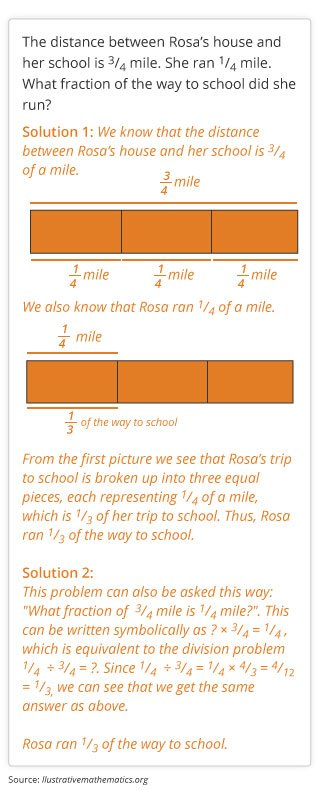
Knowing how to work with fractions helps students as they start studying ratios, which are a main focus in sixth grade. Sixth graders work on three main skills using ratios: 1) ratio and rate language; 2) recognizing, generating, and graphing pairs of equivalent ratios; and 3) comparing ratios. Ratios express the relative size of two (or more) quantities or numbers. Kids talk about ratios using words such as 3 to 2, or 3 for every 2, or 3 out of every 5, or 3 parts to 2 parts.
Watch how sixth graders calculate equivalent ratios.

Sample problem 2: Using ratios to solve problems
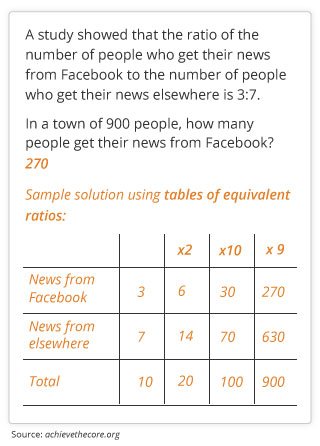
Ratios have associated rates. For example, the ratio 3 feet for every 2 seconds has the associated rate 3⁄2 feet for every 1 second. In sixth grade, students describe rates in terms like for each 1, for each, and per. This is called the unit rate.
Students can calculate the unit rate of a ratio to compare two quantities or find proportional rates (like speed). In the following problem, students must draw on their knowledge of rates to determine who walks faster per 1 second. Why? Because it’s difficult to compare walking rates when they’re in different amounts of time.
Sample problem 3: Calculating and comparing unit rates
Students also learn about percents — sort of a sister to ratios that means per 100. As they become familiar with percents, students will be able to do mental math using common percentages known as benchmark percents, such as 10%, 25%, and 50%. Knowing how to do these calculations in your head comes in handy when you want to leave a 20% tip on a $36 restaurant bill, or when you want to know how much money you’ll save when a $35 pair of jeans is 15% off.
Sample problem 4: Percents
Before sixth grade, students learned about whole numbers (0, 1, 2, 3, etc.) and fractions greater than 0. In sixth grade, kids step backwards, numerically speaking, to learn about negative numbers. On the surface, it may seem impossible for something to be less than zero, but negative numbers serve a purpose in daily life. If you accidentally take too much money out of the ATM machine, your bank balance could go below zero. If you live in a region prone to droughts or floods, the water level may be described as below or above sea level, with 0 representing sea level. Not enough water, or below sea level, is a negative number. Then there’s the temperature; if you’ve lived through a New England winter you already know what it means when the temperature falls into negative numbers, or below zero. By the end of sixth grade, your child should understand situations that involve negative numbers (like the ones just mentioned). Sixth graders should also be able to place negative numbers on a number line to show the relationship between numbers. (For example, -12 is less than -5 because it is further away from 0; and in a context, -12 degrees is colder than -5 degrees.)
Sample problem 5: Negative numbers
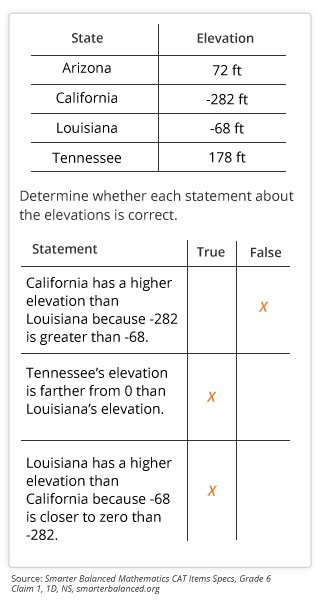
Since kindergarten, students have been writing numerical expressions, starting with basic addition, such as (2 + 3), and moving into more complex problems, such as (8 x 5) + (2 x 6). In sixth grade, students need to convert these into algebraic expressions by using variables, or letters that represent unknown numbers. For example, subtracting y from 5 would be written as 5 – y.
Sixth graders use variables in word problems. A test question might pose this situation: Daniel spent $10 on 5 candy bars. Write an equation to determine how much each candy bar cost. The answer is 5x = 10 or 10 ÷ 5 = x, where x is the cost of one candy bar. Here’s another one.
Sample problem 6: Writing and solving equations with variables

Sixth graders also use variables with ratios and rates. For example, let’s say you’re driving at a speed of 60 miles an hour. Students may be asked to create an equation showing the distance traveled after 3 hours. It would look like this: 3 x 60 = x.
In the following word problem, students must first identify the patterns for x and y before calculating the relationship between x and y.
Sample problem 7: Working with variables in ratios and rates
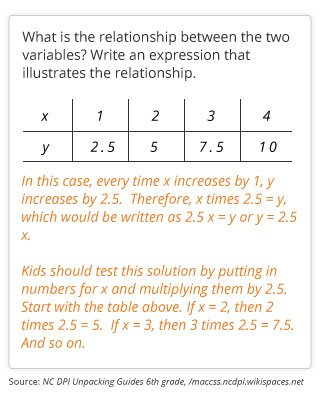
Sixth graders also work with inequalities, which are expressions that say two things are not equal. Inequalities use the signs > (greater than), < (less than), or ≠ (not equal). Students should be able to interpret inequalities and represent them on a number line.
For example, the inequality x > -2 shows that the variable, x, is greater than -2. Since x is a variable, it includes all numbers greater than -2, such as -1, 0, 1, 2, 3, 4, etc. The inequality x > -2 is shown on the number line below. The arrow means that it goes on forever in that direction, meaning that x can equal any number greater than -2.

Sample problem 8: Inequalities
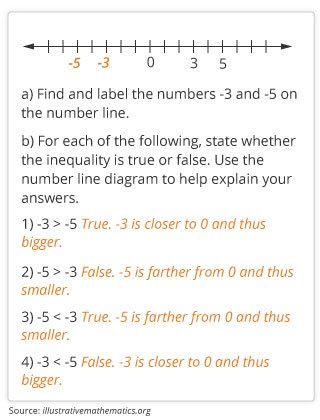
The most important thing you can do to help your child with math is to have a positive attitude toward math, and find ways to demonstrate that to your child. Why? Because research shows that a parent’s attitude toward math is contagious; so just by having a good attitude you are helping your child with math. So yes, you are a math whiz — and your child will be one, too.
Start by asking your child’s teacher about your child’s grasp of the why and how. First, does your child understand the why behind the concepts in sixth grade? Does he know why dividing a fraction by a fraction requires multiplication? And why a negative number is to the left of 0 on the number line? Next, does your child understand how to do the problems? If not, where does he struggle? (Is it dividing fractions, writing the equation, filling in ratio tables?) Ask the teacher to help identify the specific concepts and procedures that your child is struggling with most.
We all know it’s important for kids to master division, fractions, and equations. But math is more than memorizing facts or even procedures. Math also teaches an essential skill: problem solving. Sixth graders are expected to be able to solve problems even when the path to solving the problem isn’t clear. Students should be comfortable asking and answering questions such as: What is this problem asking me to do? How do I know this is correct? Does this make sense? How else can I solve this?
Modeling and data analysis means taking a real-world problem and using math to solve it — by creating a graph, drawing a picture, using a number line, creating a table, or building a model. In sixth grade, students apply the concepts and procedures they’ve learned to solve real-world problems.
See how a sixth grader solves a word problem involving ratios.

Sixth graders are expected to figure out how to solve problems that don’t tell them which procedures or techniques to use. Students need to identify the important information in problems, figure out which steps to take, and choose what tools to use (for example, pictures, graph paper, or a ruler) to find the answer. Many problems, such as the sample problem below, can be solved using a variety of techniques. Your child should be able to read a problem and find the answer using a technique that works for him. He should also be able to make sense of other approaches and show multiple ways to solve a problem.
Sample problem 1: Analyzing a problem and looking for ways to efficiently solve it

Students learn to show and make sense of how quantities change in relationship to one another using graphs and tables. For example, in the sample problem below students are asked to find the rate of two bikers using the data presented.
Sample problem 2: Making sense of quantities and their relationships

Sample problem 3: Modeling, or using mathematics to solve real-world problems
The math gene is a myth! There’s a common misconception that some people are born with a math brain and some aren’t. Not true. With support, practice, and encouragement, kids can — and will — learn math.
Teachers want to work with you to help your child. Ask for specific information about your child’s strengths and weaknesses. Ask for suggestions on math exercises you can do at home. Maybe there’s a card game or board game that helps with reasoning skills. Get some advice on how to talk to your child in a way that encourages her.
How did I do this? How do I know I got the right answer? Can I explain my work to the class? Sixth graders will be asking themselves these questions all year. Throughout the year, they need to use their new knowledge of ratios, the number system, and expressions and equations to explain how they arrived at an answer. They need to prove why their answer to a problem is correct. And, they’re asked to (nicely) evaluate their classmates’ work.
Sixth graders need to be able to use their knowledge of mathematical rules to defend their work. For example, they need to be able to explain why multiplying two negatives always makes a positive, or why any number times 1 equals the original number.
Students should be able to analyze how a problem has been solved and, if it’s not right, point out where things went wrong. Kids also need to be able to explain what the correct solution would be and how — and why — it works. Sixth graders need to be able to use mathematical language and definitions in their explanations.
Sample problem 1: Evaluating other kids’ answers using reasoning
Students need to be able to use the skills they know to answer questions and figure out how to go about solving multi-part problems. They also have to understand the math well enough to explain their work and use their knowledge of concepts and procedures to support their reasoning. The following problem requires all of that.
Sample problem 2: Supporting reasoning
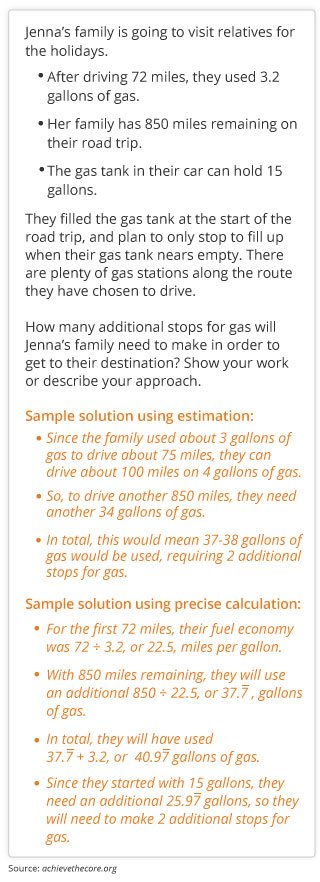
Be kind to math. Don’t let math get a bad rap at your house because you can pass negativity about math on to your child. It’s true. Instead, talk about all the ways that math makes your life easier. Make “better living through math” a motto at your house.
You don’t have to wait for the parent-teacher conference to talk to your child’s teacher. Arrange a meeting and talk with the teacher sooner rather than later. Ask the teacher what the class is working on, and ask specifically what your child is doing well and where he is struggling. If you can, look at examples of your child’s work while you talk — it makes it easier to understand how you can help. Ask for tips on how you can help your child improve as well as suggestions for other resources outside of school, such as websites or workbooks.
GreatKids created this guide to help you understand your child's state test scores and to support your child's learning all year long. We worked with SBAC and leading teachers in every grade to break down what your child needs to know and exactly how you can help